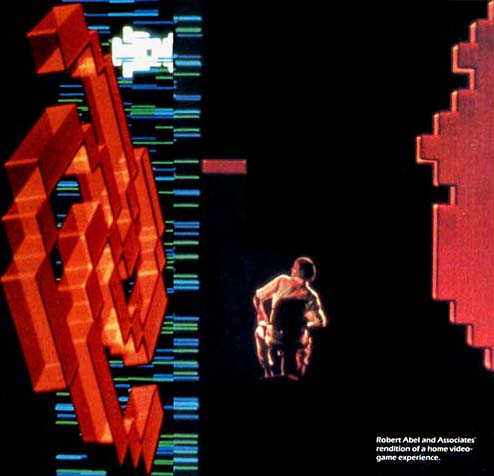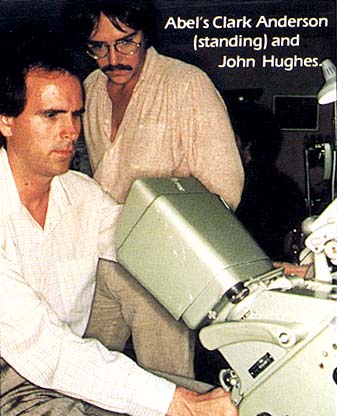
It begins like any television
commercial: a simple film of real life. A designer of video
games, played by actor Rod Davidson, sits in his office. He
is swiveling in his chair, musing.
"I'll have a fly," he says suddenly, "a mutant fly." And with that,
a huge, flying object that resembles a video-game creature looms in the
air before him-- buzzing and pulsating in a graphic fever.
"Hello, Yar," Davidson says calmly, naming the fly, "You'll need some weapons."
With this, the weapons -- blades of flickering light -- appear. "Because
you'll have a formidable enemy -- the Qotile." Directly
in the back of Davidson, the Qotile sneaks into view. And suddenly
a battle erupts: Yar versus the Qotile, both streaking, shooting,
bursting with color and motion above, below, and behind.
It's all part of a new,
two-minute commercial that Atari has produced for movie theatres.
If the spot is as successful as the company hopes, it will move you to
buy three new Atari products (including the game Yars' Revenge).
The company that produced
the ad for Atari is the Los Angeles-based studio Robert Abel and Associates.
When you visit Abel's shop, you see all the signs of a breakneck pace:
30 phone calls to the switchboard in 10 minutes, couriers to Tokyo cooling
their heels as rush deliveries are hurriedly packaged. The demand
for this work is high, even at an average cost of $100,000 for a 30-second
spot. As Bob Abel himself explains, "Firms have new technolgoy to
sell, and they realize they can't use an old-looing commercial to sell
it."
Two of the Abel staffers
behind the Atari commercial were designer-director Clark Anderson and codirector
and technical expert John Hughes. "The Atari storyboard as we first
received it was conceived in very flat terms," says Anderson. "But
we knew we had a big theatre screen to work with--twice as wide as it was
high. And we have the E&S [Evans & Sutherland] machine, which
we use to choreograph computer graphics to give an illusion of three dimensions."
So Anderson redrew the storyboard to show what the team at Abel could do.
"I knew that the game elements the character was creating would be more
interesting if they were flying at him, or around him, rather than just
happening in front of him."
Next the Abel team
constructed an animatic: a full-perspective mock-up of the commercial displayed
on the system's high-resolution, black-and-white video screen. Explains
Anderson: "In a commercial as this, our pacing, timing of pictures
to words, and camera angles all must be set in advance. That's what
the animatic shows us."
 To create the animatic, the Abel staffers must enter line drawings representing
the elements in the commercial (including a simple outline of the actor
and his chair) into the E&S computer. A drawing of a particular
object can be placed atop a data tablet -- an electronic drawing tablet
-- linked to the computer and outlined by hand with a special stylus.
Some shapes are easier than others. "To express a square, for example,"
says Anderson, "I'll mark its four corners with the stylus. For drawing
in three dimensions, I mark points for three views--side, top and front.
"Some shapes, as Hughes notes, are created by typing commands on the computer's
keyboard: "With our software, if an object has curved surfaces, it's
easier to create it mathematically."
To create the animatic, the Abel staffers must enter line drawings representing
the elements in the commercial (including a simple outline of the actor
and his chair) into the E&S computer. A drawing of a particular
object can be placed atop a data tablet -- an electronic drawing tablet
-- linked to the computer and outlined by hand with a special stylus.
Some shapes are easier than others. "To express a square, for example,"
says Anderson, "I'll mark its four corners with the stylus. For drawing
in three dimensions, I mark points for three views--side, top and front.
"Some shapes, as Hughes notes, are created by typing commands on the computer's
keyboard: "With our software, if an object has curved surfaces, it's
easier to create it mathematically."
Once an image appears
on the video screen, Anderson and Hughes can move it around with a joystick
or a series of knobs. "Motion-control cameras can only physically
pitch and yaw a given distance," says Anderson, "but once you take choreography
completely into the computer, you can fly objects on-screen all over the
place and not worry about tangling up the wires and equipment."
With the animatic as
a guide, the elements for the final, on-film shoot are assembled.
First, Abel's older, motion-control cameras are used to photograph the
logo and titles. The camera slides toward or away from the titles
on a trach up to 50 feet in length. The titles themselves are positioned
on a light box, which can move in the same roll-pitch-yaw configuration
as the creatures on the video screen ("Its run by the same software," explains
Hughes).
Then, in another room,
the resulting footage may be streaked--the industry's word for the time-exposure
technique that can make a network logo look like it has a vapor trail.
"It's simple" Anderson explains. "You open the lens of your camera
partway while it's moving, smearing the image."
What about filming
in an all the objects outlined by the computer? Abel's vector graphics
system produces only white lines, not solid area, so the computer is instructed
to display a thicket of tightly packed parallel lines that, at a distance,
resembles a solid shape. Then there is the task of adding color
and shading to all these lines. "For most of the Atari job," says
Hughes "we simply placed color filters between the video screen and our
thirty-five-millimeter movie cameras."
Finally, its time to
film the live-action part of the commercial. For the Atari spot,
the live action was filmed in front of what appeared to be a blue, 40-by-60
foot light box turned on its side so the background could later be dropped
out. "In the finished spot, the animated effects would be zooming
around the actor." notes Anderson, "so as we shot him live, we also had
to throw light on him from different directions. To pull the off
in the commercial, we used a system of computerized lighting cues, like
the systems used at large rock concerts. It coordinated eighty lighting
events in two minutes." For cues, the actor watched the animatic
on a hidden video monitor. "It took three days to coordinate all
of it and program the lighting," says Anderson, "but we did the actual
shooting in one day." After the matting process blended the synthetic
and live-action footage, all that remained was to add the sound effect,
make prints, and then produce copies.
"But the technology
is not in charge here," says John Hughes emphatically. "All of the
power is where it should be, with the designers."
To view the actual commercial which was
shown during the previews
before the movie Star Wars: Return of
the Jedi, click the link below.
Atari
"The Fly" Commercial
1 min, 57 sec. 3.3mb
AVI